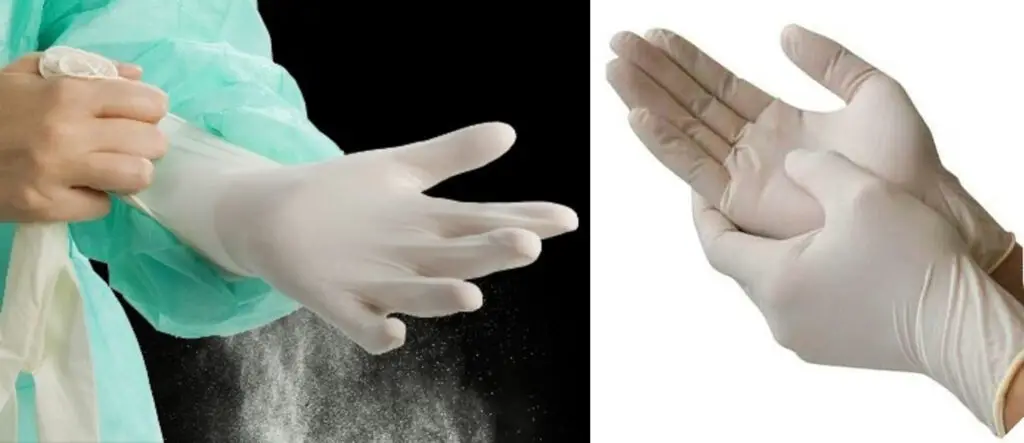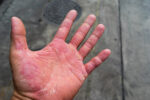The most prevalent type of safety glove is disposable latex gloves. They are constructed of natural latex, which allows them to be more fitting and elastic, and they are widely utilised in numerous sectors, most notably food processing, medical and health care facilities.
Disposable latex gloves are classified into two types: powdered and powder free, each with its own set of advantages and disadvantages. In this article, we’ll take a closer look at the distinctions between powdered latex gloves and powder-free latex gloves.
The fundamental distinction between powdered and powder-free gloves is that powdered gloves include a powder that makes them easier to put on and take off. Non-powdered gloves, on the other hand, go through chlorination, a procedure known to make latex gloves less form fitting, reducing the necessity for powder for easier putting and removing.

Let us discuss the above mentioned points in detail.
Powdered gloves
1.) Powdered gloves include cornstarch, which aids in grip and quick donning while also decreasing moisture from your hands.
2.) Because of their quick and efficient usage, they are quite popular in the healthcare business. After each usage, the powdered disposable glove is discarded.
3.) If you sweat excessively, the powder within the gloves will soak the sweat, making the gloves simpler to wear and take off.
4.) Powdered gloves can stick to the user’s skin and produce sensitivities or allergies if worn for an extended amount of time. Latex allergy or sensitivities may potentially be exacerbated by cornstarch powder.
5.) Concerns have also been expressed at food service establishments concerning powder from powdered gloves clinging to hands, clothing, or surfaces after removal and contaminating food.
Powder free gloves
1.) Powder-free gloves are the polar opposite of powdered gloves since they do not include corn starch. It makes these gloves much more flexible and easy to accessorise.
2.) They are typically used in the food and mechanical industries. They are available in latex, vinyl, and nitrile varieties.
3.) These are skin-friendly and significantly more powerful, and will not harm your hands.
4.) Non-powered gloves are treated with a chlorine solution, then rinsed with water, and dried to remove the bulk of the residue left of powder and latex proteins. This process is called chlorination.
Because of the extra work required in the chlorination process, powder-free gloves are also more expensive than powdered gloves.
The disadvantage of the technique is that powder-free gloves are more difficult to remove quickly and may reduce the hardness of the glove’s grip.
Here are some advantages of powdered and powder free gloves.
Pros of powdered gloves-
1.) The design is strong, making it simpler to wear.
2.) These are less expensive than powder-free gloves and are typically purchased in bulk.
3.) You may quickly replace your gloves by tossing one powdered glove and using another the next day.
4.) It helps to reduce perspiration since the powder absorbs the starch found within the gloves.
Pros of powder free gloves-
1.) These gloves are sturdy and long-lasting, making them useful in harsher environments.
2.) It is adaptable and water-resistant, making it ideal for use in the food and chemical industries. Wearing these gloves will safeguard your hands.
3.) It results in a significant reduction in the danger of contamination during the packing of food products.
4.) Powder-free gloves are gentler on the skin than powdered gloves.
5.) Provides a strong grip for dealing with and tackling difficult tasks.
What does the FDA have to say about powdered gloves?
On Friday, the US Food and Drug Administration (FDA) issued a final rule restricting the use of powdered medical gloves beginning January 19, 2017.
The FDA suggested the restriction, noting evidence that such gloves presented substantial dangers to patients, such as airway and wound irritation, post-surgical adhesions, and allergic responses.
After the restriction was proposed, Jeffrey Shuren, director of the Center for Devices and Radiological Health, stated,
“This ban is about protecting patients and health care professionals from a danger they might not even be aware of.”
The FDA specifically states that it will prohibit the sale, distribution, and manufacture of all powdered surgeon’s gloves, powdered patient examination gloves, and absorbable powder used to lubricate surgeon’s gloves.
So, are powdered gloves really harmful?
Well, we believe in the FDA and their recommendation right?
But we will provide you evidence of why powdered gloves are harmful-
1.) There has been research and studies that reveal that glove powder on medical gloves might exacerbate foreign body responses, promote infections, and function as a carrier of natural latex allergens.
2.) To decrease exposure to natural latex proteins, the National Institute of Occupational Safety and Health (NIOSH) has issued a safety notice urging the use of powder-free, reduced protein content latex gloves.
3.) Dry lubricants like cornstarch and silicone are used to make wearing gloves simpler and to keep gloves from sticking together during the manufacturing process.
4.) The most popular lubricant for patient examination gloves is cornstarch, which fits the requirements for absorbable dusting powder.
And how does non-powdered gloves come to our rescue?
Chlorine reacts with the natural rubber latex surface to reduce discomfort, eliminating the need for dusting powder.
The additional washing performed during the chlorination process has the additional benefit of greatly decreasing the quantity of natural latex proteins and powdered allergens.
Because of the increased awareness of these issues in the United States, the majority of exam gloves and surgical gloves used in hospitals are powder free.
Chlorination processing necessitates more thorough washing during manufacture, resulting in a glove with significantly less free latex proteins and other residual contaminants. This procedure greatly minimises allergic responses.
To conclude, we now know that non-powdered gloves are far better for your health. And also, there isn’t much difference between both powdered and non-powdered gloves in terms of strength, durability and flexibility.
However, implicating a ban on an item does indicate that it isn’t safe to be used. Therefore, make careful choices and that is why in this article, we have included all that we think is important for your knowledge.







